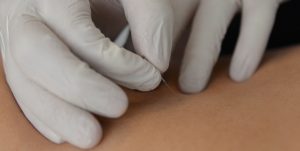Intramuscular Stimulation (IMS)
They call it a “good” or positive pain because a quick muscle "grab" is followed by a feeling of relief and relaxation.
What is Intramuscular Stimulation (IMS)?
IMS uses implements adapted from traditional acupuncture and is based on scientific neurophysiological principles. During a treatment session over active muscle fibers are identified and a thin acupuncture needle is briefly inserted. Because the muscle is supersensitive and shortened, you’ll feel a peculiar sensation—like a muscle cramp or Charlie Horse. This distinctive type of discomfort is caused by the muscle grasping the needle. Patients soon learn to recognize and welcome this sensation and call it a “good” or positive pain because it is followed by a feeling of relief and relaxation. Multiple fibers may need to be needled, even in a small area, to reduce the spasm and pain in the region.

The effects of IMS
The effects of IMS are cumulative– needling stimulates a certain amount of healing, until eventually, the condition is resolved and the pain disappears. Some patients treated with IMS have remained pain-free for over 20 years.
Frequency of treatments
Treatments are usually once a week (but can be spread out to two weeks) to allow time between treatments for the body to heal itself. The number of treatments you require will depend on several factors such as the duration and extent of your condition, how much scar tissue there is (usually increased after previous surgery), and how quickly your body can heal. The rate of healing depends on the condition of your nerves (young people usually heal more quickly, although older is not necessarily slower). If the pain is of recent origin one treatment may be all that is necessary. In published studies of patients with low back pain, the average number of IMS treatments required was 8.2
Neuropathy - what happens when nerves start to go wrong
Doctors usually have no difficulty in treating pain caused by injury (a fracture, for example) or inflammation (such as rheumatoid arthritis). Often they are perplexed by pain that shows no sign of tissue damage or inflammation, such as headaches, “whiplash”, backache, tennis elbow, or frozen shoulder. Dr. Chan Gunn, the developer of IMS, introduced the concept of “neuropathic pain” that occurs when nerves malfunction following minor irritation. Nerves and nerve-endings become "super sensitive" and cause innocent, harmless signals to be exaggerated and misperceived as painful ones. The result is pain, even when extensive medical tests show there is “nothing wrong”. Until recently, supersensitivity has received little attention in medical circles.
Treating Neuropathic pain
Supersensitivity and muscle shortening cannot be operated on and “cut away”. “Pain killers” and other analgesic pills only mask the pain. The goal of treatment is to release muscle shortening which presses on and irritates nerves. Supersensitive areas can be desensitized and the persistent pull of shortened muscles released.
A new understanding of chronic pain
Many people who suffer from chronic pain become frustrated and depressed when their doctors cannot help. Some try medications and traditional physical therapies (such as massage, physiotherapy and manipulations), even surgery, and do not find lasting relief.
IMS is an effective treatment for chronic pain, even when there is no injury or inflammation, and offers a scientifically proven method for diagnosing and treating it.
How IMS compares to Traditional Acupuncture
| Traditional Acupuncture |
| Medical Examination not applicable |
| Medical diagnosis not relevant |
| Needle insertions according to Chinese philosophy into non-scientific meridians |
| Needles inserted and left in place |
| Multiple needles at the same time |
| Treatment focus on energy and meridians |
| IntraMuscular Stimulation |
| Medical examination is imperative |
| Medical diagnosis is necessary |
| Needle insertions into muscle bands and neuropathways |
| Needle inserted manually and then removed |
| Treatment focus on supersensitivity and neuropathic pain |
